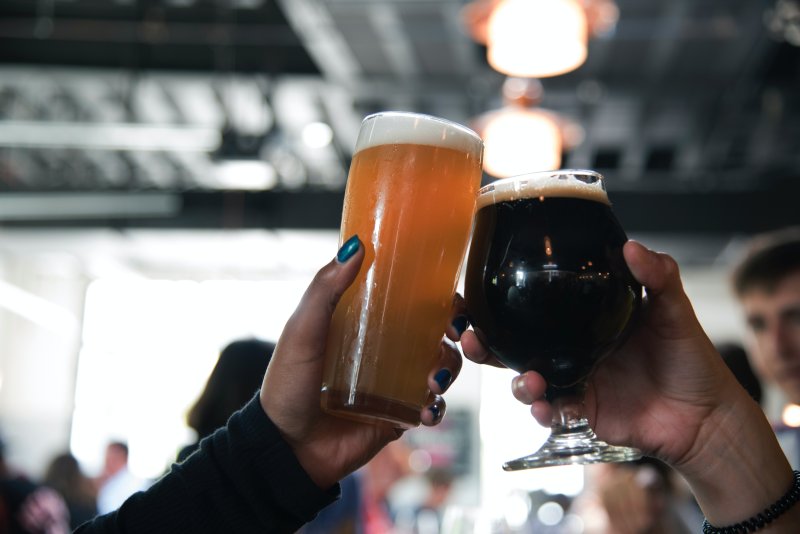Filter Search
Show available only
Categories
Price
Select all
Clear all
$0 - $10
$10 - $50
$50 - $100
$100 - $500
$500 & above
Filter Search
Show available only
Categories
Price
Select all
Clear all
$0 - $10
$10 - $50
$50 - $100
$100 - $500
$500 & above
Product is not availabe in this category, please select other category
ALL ABOUT STOUT
Brewers began crafting stout beers in 1720 out of London, England. They quickly gained popularity thanks to their strong flavor and affordability. They also take longer to spoil and are more heat tolerant than similar brews. The term stout comes from an old adjective meaning “brave” or “proud”, but eventually became synonymous with the term “strong”. The beers took on the term due to their high ABV (alcohol by volume) levels. Stouts typically present tan to brown and opaque. Their thick heads trap in aromas and carbonation so they can be sipped slowly and enjoyed at your own pace. Common flavors associated with stouts come across as rich and full, tasting of coffee, chocolate, licorice, and molasses. Their hops generally come across less pronounced than other beers unless the brewer wants to accentuate them. The biggest difference between stouts and porters lies in the grain used to craft them. Stouts use unmalted roasted barley, while porters get made with malted roasted barley. Because of this, stouts present darker and more flavorful than porters. If you’re looking for a great beer to complement most meals, check out our stout selection and get them delivered today!

History
The first manuscript referring to stout as beer appeared in 1677 in the Egerton Manuscript. Eagerton, a clergyman in the Church of England, used stout to simply refer to strong beer. During the 1800s, the terminology stout got tacked on to porter, which muddied the two categories and still does to this day. Stout, as a term meaning strong, became associated with any strong type of beer like “stout pale ale” in the UK. Since early brewers often used the name stout to describe strong beers, stout porter causes a lot of confusion in its history. In 1722, Ralph Hardwood began mixing beer, strong beer, and ales together into a concoction he named “entire”. Also referred to as “three threads”, which likely changed from a linguistic pronunciation of “three thirds”, the beer he created quickly gained popularity among the porters and merchants delivering beer to pubs and distributors. Pretty much any bartender could mix together the three types of beer to make a stronger version of the product they were already selling. The resulting beers changed the way brewers produced their product. Originally, brewers needed to wait six to eight months for large batches of beer to ferment and rest. By mixing beers together, they could now mix one highly-aged beer (18+ months) with weaker porters and replicate the taste almost identically. One batch brewing over time meant the other vats could be put to use immediately. The notoriety stout porters originally gained fell off during wartime in the 1860s since grain taxes raised considerably. By 1941, most breweries discontinued stout porters entirely. Stouts and porters faded into obscurity until 1972, when the Anchor brewing company started releasing porters again. Many breweries followed suit and the style saw a resurgence. Michaell Jackson, an English beer critic (not the singer!), wrote about porters and stouts in the 1970s, and What’s Brewing, a survey done in the UK, found 29 brewers still crafting stouts, most of them milk stouts. In today’s society we see many more breweries attempting to recreate the style in their own fashions and a few different styles of stouts emerging. Because using the term stout as a synonym for strong mixed up the porter and stout styles, many beer aficionados claim the terms still need more clarification. Regardless, stouts now refer to beers crafted using unroasted malted barley. Stouts present darker and more flavorful than porters and will only become more popular as the term gains more popularity and clarification over time. Common varieties now include imperial, milk, oatmeal, and dry stouts.
How Stout is Made
Brewers make stouts by milling their chosen grains and creating a mash that will hold the traits they desire. They then heat the mash until the enzymes convert. They mix this into near boiling water and keep the mixture moving by stirring or recirculating it. They then sparge, which means to moisten or sprinkle with water, the mash and collect the wort, the sweet, unfermented infusion of ground malt, by straining out the materials. The resulting wort gets boiled for another hour and half. Brewers then add hops and boil the concoction for an hour. After adding a small amount of hops at the last five minutes, they chill the wort and aerate the mixture completely. Next, they begin the fermentation process by pitching the yeast into the wart and ferment the mixture until the yeast drops and the beer becomes clear. The mixture gets left alone for two days past the point it appears finished, which helps to mellow out acrid flavors and let others take the lead. Finally, the brewers keg the beer, add some priming sugar, and keg or bottle the beer depending on the needs of their distributors. Processes can vary a bit depending on the brewers intended tastes and flavors, but the processes closely resemble each other.
WHAT DO STOUTS TASTE LIKE?
Stouts carry thick bodies and heads with pronounced flavors described as coffee, chocolate, liquorice, and molasses. The four main types of stouts (imperial, milk, oatmeal, and dry) offer tons of variation within each subcategory. Many brewers play with the flavors and offer other great flavors like coconut, vanilla, peanut butter, graham crackers, syrups, blueberries, and cinnamon among others. Take a look at the individual product descriptions to determine which stouts will best compliment your tastes and preferences. Enhance your meals, desserts, and relaxation with one or more of LiquorSplit’s premium stouts. Avoid the longs lines and hassles of the grocery store, and get your favorite stouts shipped right to your front door!

How to Drink Stout
Some glass makers actually craft glass specifically intended for stouts. While these options exist, brewers and bartenders often suggest serving them in pints, tulip glasses, or goblets. Glasses chosen should be wide mouthed and not too thick or insulated. Since there are so many different types of stouts, not all pour exactly the same. A general rule of thumb says to “pour hard” so that the head actually forms since many stouts lack heavy carbonation. Also, you won’t end up feeling bloated after drinking them! Stout flavors actually come forward as they warm up. When cold, the hops present stronger than other flavors and taste bitter. After letting it sit for a bit, the aromas and flavors come to life. This makes them perfect for relaxation since you can go about your normal routine and just leave them out to warm up to around 44-45 degrees fahrenheit. Want something to sip slowly and take your time with? Check out LiquorSplit’s stouts and jumpstart your relaxation.
What Makes Stouts Popular
Stouts attract tons of beer lovers seeking out rich flavors to add complexity to their meals and relaxation. The fermented black beer also provides good levels of iron, vitamins, and antioxidants for health-conscious drinkers. They offer full-bodied mouth feels and a huge variety of flavors commonly include chocolate, coffee, liquorice, and molasses. The hops used in them vary as well and can be barely noticeable to medium/medium high in flavor depending on brewer preference. Stouts pair well with most dishes. They taste especially good alongside smoked, salty, barbecued, braised and grilled dishes. Stouts accentuate meats, oysters, rich stews, chocolate, and less-sweet desserts. They also make excellent additions as a braise, which means adding it into the meats and vegetables as they cook, or as an additional ingredient in chocolate baked goods that could use some extra malt or cocoa flavors. Check out our selections of stouts today and deliver an extra kick to your meals and downtime!
Please select your delivery location for us to get the order deliver faster.
Home
Cart
Profile
Location
